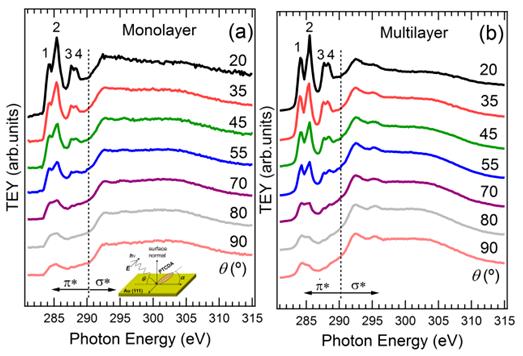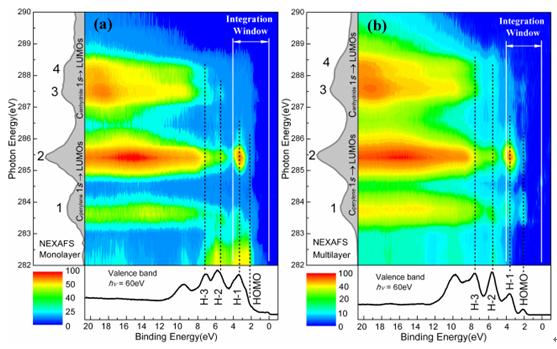| Structure and charge transfer dynamics of the PTCDA/Au(111) interface probed by resonant photoemission spectroscopy |
| From: PublishDate:2012-06-25 Hits: |
Organic semiconductors have attracted widespread interests due to their promising applications in organic electronic devices such as organic panel displays and photovoltaic cells (OPVCs). In these devices, the molecular orientation and interfacial coupling, which are found to markedly affect the charge transfer process, determine the device performance. For example, lying-down orientation could improve the charge transfer timescale. Ultrafast charge transfer at the organic/substrate interfaces is necessary to compete effectively against various loss processes and increase the efficiency of solar energy conversion. Synchrotron-based core-hole clock implementation of resonant photoemission spectroscopy (RPES) and near-edge X-ray absorption fine structure spectroscopy (NEXAFS), is a novel technique and has been successfully utilized to probe the ultrafast charge transfer dynamics at organic/inorganic interfaces using the core-hole lifetime as an internal reference clock. This method allows the quantification of the delocalization of electrons from unoccupied molecular orbitals to a substrate with fs or sub-fs timescale. In addition, angular dependent NEXAFS has been found to be a powerful tool for characterizing the adsorption geometry of planar aromatic molecules on a solid substrate. Surface Science group from University of Science and Technology of China (USTC) had investigated the molecular orientation and charge transfer dynamics at PTCDA/Au(111) interface using angular dependent NEXAFS and core-hole clock spectroscopy. PTCDA molecules are found to be lying-down on the substrate with high degree of orientational order. The charge transfer timescale at the PTCDA/Au(111) interface is much larger than the C 1s core-hole lifetime of ca.6 fs, indicating weak electronic coupling between PTCDA and the gold substrate due to the absence of chemical interaction and/or bonding. It turns out that gold may not be an ideal electrode for PTCDA-based organic device applications owing to the slow charge transfer dynamics at this specific interface. The research results have been published on November 1st 2011 in Journal of Chemical Physics. Good evaluation on the application of core-hole clock spectroscopy on organic/metal interface was provided by referee of Journal of Chemical Physics: “This paper contributes some much needed data for those attempting to apply the core-hole clock principle to organic molecules on metal surfaces. This is a really challenging area, much more so than the application of resonant photoemission to molecules on wide band gap semiconductors such as TiO2.” The research revealed the nature of interactions and the influence of molecular orientation on charge transfer dynamics at PTCDA/Au(111) interface. In addition, this research results lay a solid foundation for the application of core-hole clock technique at organic/inorganic interfaces. The photoemission spectroscopy endstation at 4B9B beamline of the Beijing Synchrotron Radiation Facility (BSRF) where the experiments were carried out is upgrading now. The new endstation will include a Scienta R4000 analyzer for ARPES and multi-function chambers. More high level researches on the new apparatus are highly expected. Fig.1 Angular dependent C K-edge NEXAFS spectra for monolayer (a) and multilayer (b) PTCDA molecules on the Au(111). The inset shows the measurement geometry. The spectra show that the intensities of the p* resonances enhance with decrease of incident angle, whereas the σ* resonances show the opposite dependence. Fig.2 RPES spectra for monolayer (a) and multilayer (b) PTCDA on Au(111). The bottom spectra are corresponding VB spectra measured with photon energy of 60 eV and the spectra on the left side is their respective NEXAFS spectrum. The fact that significant resonant features can be clearly resolved in both monolayer and multilayer PTCDA on Au(111) suggests that the photo-excited electrons are considerably localized in the molecules without obvious charge transfer to the substrate within the core-hole lifetime. Article: Liang Cao, Yu-Zhan Wang, Tie-Xin Chen, Wen-Hua Zhang, Xiao-Jiang Yu, Kurash Ibrahim, Jia-Ou Wang, Hai-Jie Qian, Fa-Qiang Xu,* Dong-Chen Qi,*Andrew T. S. Wee*, Charge transfer dynamics of PTCDA molecules on Au(111) probed by resonant photoemission spectroscopy, Journal of Chemical Physics, 2011, 135, 174701. |
|
|
| Chinese
Science Highlights
Home /
Copyright © 2011 - 2012 Beijing Synchrotron Radiation Facility



